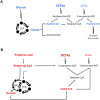Impact of glucose and propionic acid on even and odd chain fatty acid profiles of oleaginous yeasts
- PMID: 39966733
- PMCID: PMC11834278
- DOI: 10.1186/s12866-025-03788-w
Impact of glucose and propionic acid on even and odd chain fatty acid profiles of oleaginous yeasts
Abstract
Background: Odd chain fatty acids (OCFAs) are gaining attention for their valuable medical and nutritional applications. Microbial fermentation offers a sustainable and environmentally friendly alternative for OCFA production compared to traditional extraction or chemical synthesis methods. To achieve an economically feasible OCFA production process, it is essential to identify and develop microbial cell factories capable of producing OCFAs with high titers and yields.
Results: We selected 19 yeast species, including both oleaginous yeasts and representatives from the Ascomycota and Basidiomycota phyla, based on their known or potential ability to produce OCFAs. These species were screened under various growth conditions to evaluate their OCFA production potential. In glucose-based, nitrogen-limited media, the strains produced fatty acids to varying extents, with OCFAs comprising 0.5-5% of the total fatty acids. When using the OCFAs precursor propionic acid as the sole carbon source, only eight strains exhibited growth, with tolerance to propionic acid concentrations between 5 and 29 g/L. The strains also displayed varying efficiencies in converting propionic acid into fatty acids, yielding between 0.16 and 1.22 g/L of fatty acids, with OCFAs constituting 37-89% of total fatty acids. Among the top performing strains, Cutaneotrichosporon oleaginosus produced the highest OCFA titers and yields (0.94 g/L, 0.07 g/g), Yarrowia lipolytica demonstrated superior growth rates even at elevated propionic acid concentrations, and Rhodotorula toruloides achieved the highest proportion of OCFAs relative to total fatty acids (89%).
Conclusions: Our findings highlight the diverse capacities of the selected yeast species for OCFA production, identifying several promising strains for further optimization as microbial cell factories in sustainable OCFA production processes.
Keywords: Cutaneotrichosporon oleaginosus; Rhodotorula toruloides; Yarrowia lipolytica; Even chain fatty acid (ECFA); Fatty acids methyl ester; Non-conventional yeast; Odd chain fatty acid (OCFA); Propionic acid tolerance; Short chain fatty acid (SCFA).
© 2025. The Author(s).
Conflict of interest statement
Declarations. Ethics approval and consent to participate: Not applicable. Consent for publication: Not applicable. Competing interests: The authors declare no competing interests.
Figures






References
MeSH terms
Substances
LinkOut - more resources
Full Text Sources

